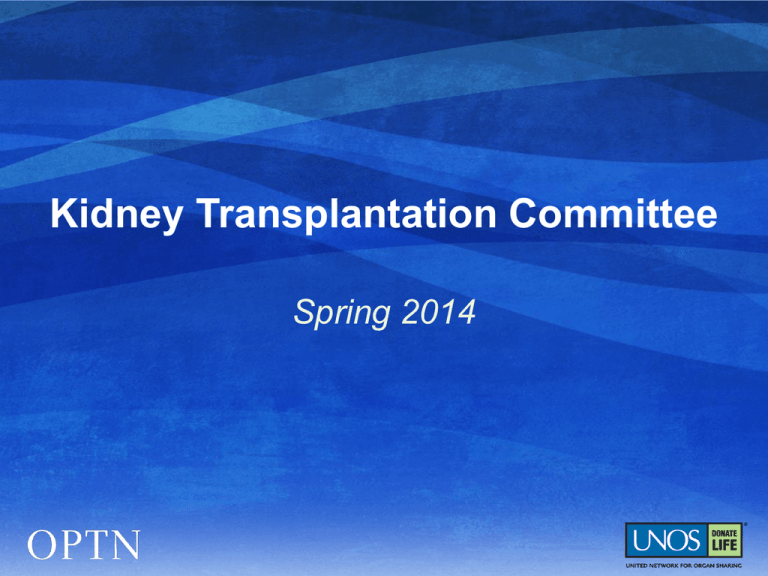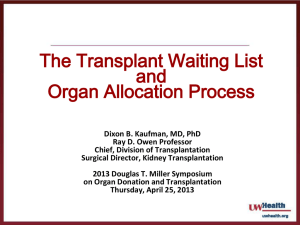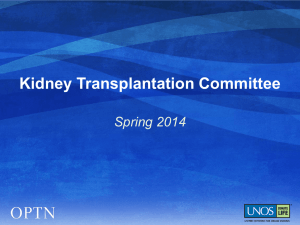priority - Transplant Pro
advertisement

Kidney Transplantation Committee Spring 2014 Allocation component changes 1. Waiting time calculation - pre-registration dialysis time added 2. Candidate classification - Estimated Post Transplant Survival (EPTS) score 3. Kidney donor classification - replace SCD/ECD with Kidney Donor Profile Index (KDPI) 4. Priority for sensitized candidates - calculated panel reactive antibody (CPRA) sliding scale Allocation component changes 5. Blood type eligibility - A2 and A2B to B compatible 6. Pediatric kidney allocation – KDPI priority 7. Kidney payback policy – eliminated 8. Kidney variances – eliminated Importance of early referral Communicate with referring physicians: o Pre-emptive listing is still advantageous o Candidates can accrue time with GFR<=20ml/ml o Priority for 0-ABDR mismatch offers Change #1 – Waiting time Current Adult Accrue time when listed, and: New or Accrue time when listed, and: on dialysis (with credit for time spent on dialysis prior to listing) or when GFR or CRCL is =/< 20 ml/min when GFR is =/< 20 ml/min on dialysis Change #1 – Waiting time Current Pediatric Accrue time immediately when listed New Accrue time immediately when listed and Credit for time spent on dialysis before listing Change #2: Candidate classification Current No priority based on estimated posttransplant survival New The 20% of adult candidates who have the longest EPTS receive priority for kidneys from donors with KDPI scores in the top 20%. Estimated Post Transplant Survival EPTS data variables o o o o Age Prior transplant Diabetes status Time on dialysis EPTS score range is 0 - 100% Sequence A Sequence B Sequence C Sequence D KDPI <=20% KDPI >20% but <35% Highly Sensitized 0-ABDRmm Prior living donor Local pediatrics Local adults Regional pediatrics Regional adults National pediatrics National adults KDPI >=35% but <=85% Highly Sensitized 0-ABDRmm Prior living donor Local Regional National KDPI>85% Highly Sensitized 0-ABDRmm (top 20% EPTS) Prior living donor Local pediatrics Local top 20% EPTS 0-ABDRmm (all) Local (all) Regional pediatrics Regional (top 20%) Regional (all) National pediatrics National (top 20%) National (all) Highly Sensitized 0-ABDRmm Local + Regional National Longevity matching Action: Review waiting time Mid–2014 System tools • Review dialysis start dates • Confirm or update dialysis start dates • Retain documentation of dialysis start dates • System will cross-reference CMS Crown database (including Form 2728) • Flag data inconsistencies Action: Input and confirm data Begin Now • Get familiar with the EPTS calculator Mid–2014 • Enter data in fields used to calculate EPTS System tools • Editable data in the system • Cross-references to OPTN and CMS dialysis dates • Flags for data inconsistency Action: Assess for living donors Prior living donors get 4 points Begin now • Check candidates for prior organ donation • Retain documentation of prior donation Change #3 - Kidney classification Current Classified as SCD or ECD based on: o donor age o history of hypertension o creatinine o cerebrovascular accident as cause of death New Classified by KDPI based on: o donor age o height o weight o ethnicity o history of hypertension o history of diabetes o cause of death o serum creatinine o hepatitis C virus status o donation after circulatory death Acceptance criteria Other independent acceptance criteria may conflict with KDPI Examples: o candidate opts out of DCD but selects KDPI max of 60% = will not see any DCD offers, even from KDPI 50% or less donors o candidate selects max donor age of 55 and KDPI of 60% = will not see offers from 56 y/o donor with KDPI 36% Action: Update acceptance criteria Begin now Mid-2014 • Review listed candidates for criteria entered • Discuss acceptance criteria for local versus import • Determine candidates that may benefit from a shipped KDPI>85% organ • Enter KDPI acceptance criteria • Assess for KDPI and “other” criteria conflicts Action: Update consents Begin now • Update consent forms - KDPI > 85% instead of ECD Implementation • New candidates listed must be consented if willing to accept KDPI>85% • Currently listed candidates • Willing to accept ECD? default to 0-100% KDPI • Not willing to accept ECD? default to 0-85% KDPI Tools available Summer 2014 • Sample language for discussing KDPI with patients • Patient brochure Change #4 - Sensitized candidates Current Priority CPRA score at or above 80% receives 4 points Moderately sensitized (CPRA 0-79%) receive zero points New Priority CPRA scores of 20% or above receive points based on a sliding scale Sequence A Sequence B Sequence C Sequence D KDPI <=20% KDPI >20% but <35% Highly Sensitized 0-ABDRmm Prior living donor Local pediatrics Local adults Regional pediatrics Regional adults National pediatrics National adults KDPI >=35% but <=85% Highly Sensitized 0-ABDRmm Prior living donor Local Regional National KDPI>85% Highly Sensitized 0-ABDRmm (top 20% EPTS) Prior living donor Local pediatrics Local top 20% EPTS 0-ABDRmm (all) Local (all) Regional pediatrics Regional (top 20%) Regional (all) National pediatrics National (top 20%) National (all) Highly Sensitized 0-ABDRmm Local + Regional National Highly sensitized before 0-ABDR Action: Update unacceptable antigens (UAs) Begin now Prior to implementation • Review unacceptable antigens reported • Enter any unacceptable antigens not previously entered (according to your center’s protocol) Action: Review and Approve UAs Mid–2014 • Reports will appear to allow Lab director and transplant physician/surgeon to approve unacceptable antigens for candidates already listed with CPRA greater than 98% System tools • Message and printable form will display when CPRA 99-100% is reached • Report listing candidates who require approvals Change #5 - Blood type eligibility Current New Kidneys allocated to candidates who are blood type identical to the donor when the donor has blood type O or B. Blood type B candidates are ineligible for A2/A2B offers. Blood type B candidates that meet defined clinical criteria are eligible for kidneys from donors with blood type A2 or A2B. Action: Develop clinical criteria Begin now • Create a protocol - maximum titer levels acceptable for blood type B candidates to blood type A2 or A2B donors Mid–2014 • Enter whether candidate meets criteria - yes or no • Retain documentation of titer levels After implementation • Update eligibility every 90 days Implementation Phase I • Data updates begin • New reports released • Calculators made available Summer 2014 Phase II • New allocation rules applied • Variances turned off • Payback system turned off December 2014 Save the date April 24, 2014 @ 2 p.m. (ET) The New Kidney Allocation System: Resources for Protocols and Processes webinar More information Recorded webinars, podcasts, toolkits, etc. available on: OPTN web site - http://optn.transplant.hrsa.gov (click ‘Resources’ and ‘Professional Resources’) Transplant Pro* - http://transplantpro.org (click ‘I am Looking For’ and ‘Kidney Allocation System’) *These are a service of United Network for Organ Sharing and are not produced under the OPTN contract. Subscribe to RSS feeds and a monthly newsletter at http://www.transplantpro.org Questions? Richard Formica, MD Committee Chair Name Region # Representative Email Gena Boyle Committee Liaison gena.boyle@unos.org Backup Slides KDPI Point changes: Sensitization Points CPRA Sliding Scale (Allocation Points) 20 18 16 14 12 10 8 6 4 2 0 0 0 (CPRA<98%) 17.30 New 12.17 10.82 Current 0 0 10 0.21 0.08 20 30 0.48 0.34 40 50 CPRA CPRA 0.81 1.09 60 70 6.71 1.58 4.05 2.46 80 90 100 Summary: Member responsibilities Communicate importance of early referral Establish protocols for A2 and A2B donors to B candidates Report/update data to calculate EPTS and waiting time Review candidates to identify prior living organ donors Establish KDPI acceptance criteria Review waiting list for unacceptable and update consents for KDPI>85% antigens Review “other” donor screening criteria Educate candidates and potential candidates on changes










